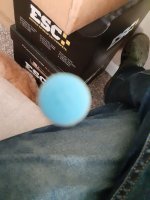Dropping your elbow is OK as long as it's after you contact the CB. If it's before then it's most likely because your grip hand is not placed correctly. I noted that in the thread with all the pics awhile back.Understood. But I think the biggest reason for my consistently hitting the CB higher than intended (and it's ALWAYS higher than I am aiming at) is because I drop my elbow. Drop the back of the cue, and the tip, on the other side of the bridge, necessarily swings up a bit.
But when I try to stroke directly THROUGH the impact point, I tend to get more draw. When I try a draw shot without dropping my elbow, I notice that even though the contact point is not necessarily really low, I tend to miscue. Using my "safe", smooth, relaxed stroke, I can draw the CB three or four diamonds on a shot where the OB is 3.5 diamonds away (9ft table). It comes back, but I never get that "delayed" spin, where the CB is seemingly sitting still for a fraction of a second before it accelerates backward like a Top Fuel dragster leaving on a green light. I on'y get a smooth backward motion.
I am only starting to get that reaction on follow shots.
It's a process. HAMB and experiment!
Last edited:

